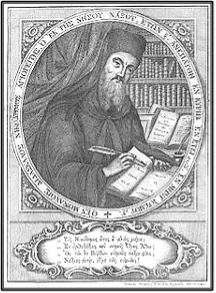The Agape Vespers
Gospel of John
Translated from Homeric Greek

By tradition, the Gospel of John (20:19-25) proclaimed at Agape Vespers on the Sunday of Pascha is read in multiple languages to highlight the universality of the Resurrection of Christ and its impact upon all mankind.
This Gospel has never been possible in Homeric Greek because many of the words used in the Gospel were not a part of the Homeric Greek language. For example, it would be impossible to describe that the doors were closed for fear of the Jews, as there was no word for Jews in the Homeric epic dialect.
But in the 18th century, Saint Nicodemos the Hagiorite brilliantly and beautifully set this Gospel to Homeric Greek and meter. In order to do so, the Gospel had to be paraphrased while capturing and retaining its message. The Saint skillfully crafted the verses by strictly using words from the Iliad and the Odyssey.
To the student of Classics, this very small translation is an impressive masterpiece. It would be virtually impossible for someone to do this today. Nicodemos had to use his imagination and exceptional talent to improvise by appropriately using Homeric words according to the requirements of the epic dactylic hexameter, with six metrical feet ending in either a dactylic (one long and two short syllables) or a spondee (two long syllables), while retaining the essence of the Gospel’s meaning. It is important to remember that in the time of Homer and in ancient Greece, and particularly in ancient Rome, the content of verse was not what made a writer great, but rather the form and the meter. A work in perfect meter would be considered a masterpiece.

From circa 1185 BC to 776 BC, when the Greek alphabet was invented, proper education among the Athenian and Ionian Greek young men would include the memorization of the works of Homer. The oral dialect of Homer was used for no other purpose but for poetry. Plato and his contemporaries would have all had Homer memorized. Saint Nicodemos had apparently read Homer a great deal and managed to accomplish something that may have been a simple thing for Plato to do but was not simple when the Saint did so in the 18th century. It was a tour de force, in that he took this small piece of Gospel and was able to craft this impressive work.
The Saint undertook this magnificent feat in order that educated persons who understood this language from memory, but who were clearly only able to use the archaic language for no other reason but to recite Homer, could experience the Gospel of John in that venue. Post-Alexandrian (from the time of Alexander the Great) koine Greek and the Greek of the New Testament are both a simpler Greek than the Homeric dialect.

1926—2022

Out of respect for the great achievement of Saint Nicodemos, in the 1970s, the Orthodox Christian Professors John C. Rouman, Ph.D. (of blessed memory) and Richard V. Desrosiers, Ph.D. (AKA Archpriest Constantine Desrosiers), of the Classics Department (1965-2000) at the University of New Hampshire in Durham, undertook the task of properly examining the Homeric Greek masterpiece of St. Nicodemos and rendering it into a literal English prose translation.
Here is that translation, published for the first time, along with the original Greek version and accompanying handwritten notes of Professor Desrosiers (Father Constantine), which for students of Classics, will shed additional information on how the scholars arrived at their translation.

The First Resurrection Gospel
According to the
Evangelist John
(20:19-25)
As rendered into the epic dialect and meter of Homer
By Saint Nicodemus of the Holy Mountain
To be read at the Vespers of Pascha
When at length the shining sun came to the West and the city streets grew dark upon the broadly nourishing earth on the first day, behold then Our Savior leapt from the tomb. Closed then were the gates, all the bolts thereof tightly fitted, fixed, and shut of the well-built great hall. Within, the disciples assembled all together in the same place, melting into tears at the shameful death of Christ the King. At that very instant came Christ the King of form Divine and stood in the midst of them openly and spake the word: “The peace of friends and lovely calm be with you.” Speaking thus, He showed them His very own side and hands. Then did the Disciples rejoice, when they saw the Broadly Ruling One.
Again then did Jesus the Sky Walker say unto them: “The peace of friends and lovely calm be with you. As the Father, Who dwells in the abodes above, sent me, so send I you onto the earth stretching broadly.” Having thus spoken He breathed upon His initiates, haranguing them: “Receive the Holy Spirit, the Bringer of Light to mortals, the One Enthroned on High. The sins of those mortals that ye have loosed upon the earth, for them then and there have they been loosed in the Star-Lighted Heaven. But at the same time the arrogant acts of those rashly talking that ye have put under ban, for these same ones their sins shall remain upon them bound with unbreakable bonds.”
Then Thomas, to whom was the surname Didymus (the Twin) for all to hear, was not there at that very time under that same roof with the other disciples before, when Jesus came. Then later the other faithful disciples shouted to Him: “We have seen with our own eyes Jesus the Ruler of All.” Answering them Thomas stubbornly said: “If I do not see the evidence of the nailing upon His hands and do not thrust my finger into His side, in no wise let there be a nod with my head in agreement with your words.”








